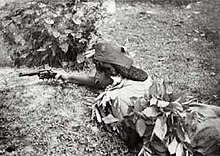Rani of Jhansi Regiment
| Rani of Jhansi Regiment | |
|---|---|

A trooper of the Rani of Jhansi Regiment in training, 1940s
|
|
| Active | October 1943 - May 1945 |
| Country | India |
| Allegiance |
|
| Branch | Infantry |
| Role | Guerrilla Infantry, Nursing Corps. |
| Size | 1,000 (approx) |
| Commanders | |
| Ceremonial chief | Subhas Chandra Bose |
| Notable commanders |
Lakshmi Swaminathan Janaki Devar |
The Rani of Jhansi Regiment was the Women's Regiment of the Indian National Army, the armed force formed by Indian nationalists in 1942 in Southeast Asia with the aim of overthrowing the British Raj in colonial India, with Japanese assistance. It was one of the very few all-female combat regiments of the Second World War on any side. Led by Captain Lakshmi Swaminathan (better known as Lakshmi Sahgal), the unit was raised in July 1943 with volunteers from the expatriate Indian population in South East Asia. The unit was named the Rani of Jhansi Regiment after Lakshmibai, Rani of Jhansi.
Bose announced the formation of the Regiment on 12 July 1943. Most of the women were teenage volunteers of Indian descent from Malayan rubber estates; very few had ever been to India. The initial nucleus of the force was established with its training camp in Singapore with approximately a hundred and seventy cadets. The cadets were given ranks of non-commissioned officer or sepoy (private) according to their education. Later, camps were established in Rangoon and Bangkok and by November 1943, the unit had more than three hundred cadets.
Training in Singapore began on 23 October 1943. The recruits were divided into sections and platoons and were accorded ranks of Non-Commissioned Officers and Sepoys according to their educational qualifications. These cadets underwent military and combat training with drills, route marches as well as weapons training in rifles, hand grenades, and bayonet charges. Later, a number of the cadets were chosen for more advanced training in jungle warfare in Burma. The Regiment had its first passing out parade at the Singapore training camp of five hundred troops on 30 March 1944.
...
Wikipedia
